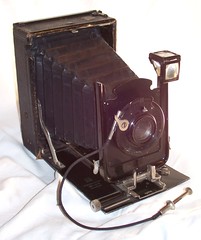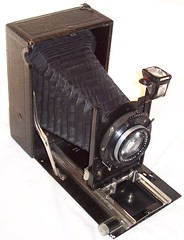Ernemann Heag II

|
| Heag II Ser. I |
Specifications Ser. I
- Type: Folding bed plate camera, lens panel holder move- and adjustable for-/backward on sliding rails
- Manufacturer: Ernemann
- Year of launch: slightly different versions launched since 1911
- Film: film plates of size 9×12 cm
- Lens/shutter-configurations (speeds O and Z are Time and Bulb mode)
- 1. Lens: Ernemann Detectiv Aplanat 1:6.8
- Shutter: Ernemann, speeds O, Z, 1/25, 1/50 and 1/100 sec.
- 2. Lens: Ernemann Detektiv Aplanat 1:6.8/13.5 cm
- Shutter: Ernemann, speeds O, Z, 1, 1/2, 1/5, 1/10, 1/25, 1/50 and 1/100 sec.
- 3. Lens: Ernemann Ernotar 1:4.5/13.5 cm
- Shutter: Ernemann Chronos >C<, speeds O, Z, 1, 1/2, 1/5, 1/10, 1/25, 1/50 and 1/100 sec., extra cocking lever for additional 1/250 sec.
- Viewfinder: Reflecting type finder, 90 degrees turnable for horizontal format, sometimes combined with spirit level
- Diaphragm: f-stops f6.8 to f36
The Heag II folding plate cameras belonged to Ernemann's products for ambitious amateurs. The name "Heag" was an abbreviation of the company's name Heinrich Ernemann Aktien-Gesellschaft and was used for a broad variety of folding camera types, numbered I, II, III, IV, etc., the different sizes distinguished by the series numbers I, II, III or other numbers.
The Heag II cameras are prepared for ground glass focusing but have also a metre scale for the focusing position of the lens panel. So it is possible to try snapshots without groundglass procedure in good light situations. The lens panel's immediate focusing after pulling it along the rails of the folding bed into operating position is infinity. The lever which locks the slide at that position can be moved aside so that focusing smaller distances by further expanding the bellows becomes possible. A scale helps to find focusing positions for 2 metres to infinity. For near object photography further bellows extension is possible. Therefore the rails can be shifted forward with help of a knurl. That allows lens panel positions beyond the end of the folding bed. This makes the cameras versatile enough for macro photography or usage of other lenses. Further versatily is given by the facilities for upward movements and sidewards movements of the lens panel. The Series I camera offers additional comfort since its lens/shutter unit is turnable. The cameras don't need shutter cocking for speeds upto 1/100 sec..

|
| Heag II Ser. II |
Specifications Ser. II
- Type: Folding bed plate camera, lens panel holder move- and adjustable for-/backward on sliding rails
- Manufacturer: Ernemann
- Year of launch: different versions launched 1911, 1913, 1917
- Film: film plates of postcard size (9.5×15 or 10×15 cm)
- 'Lens/shutter-configurations (speeds O and Z are Time and Bulb mode)
- 1. Lens: Ernemann Ernotar 1:4.5/16.5 cm
- Shutter: Ernemann Chronos, speeds O, Z, 1, 1/2, 1/5, 1/10, 1/25, 1/50 and 1/100 sec., extra cocking lever for additional 1/200 sec.
- Viewfinder: Reflecting type finder, 90 degrees turnable for horizontal format, combined with spirit level
- Diaphragm: f-stops f4.5 to f50
A Heag II Ser. III may have been also available, as well as the luxurious Heag II 75 with wooden folding bed.